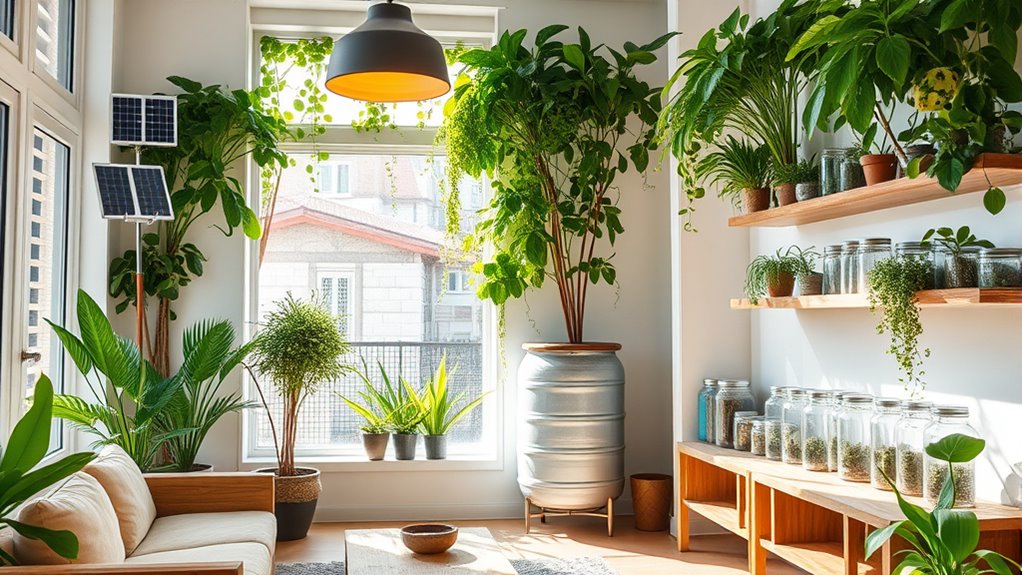To save the planet and your wallet, start by switching to LED lighting and installing a programmable thermostat to control your energy use efficiently. Use water-saving fixtures and embrace eco-friendly kitchen items like reusable containers. Maximize natural light and add insulation to cut heating and cooling costs. Grow your own herbs and reduce single-use plastics. You’ll discover more simple switches that can make a big difference for your home and the environment.
Key Takeaways
- Maximize natural light with strategic window placement and reflective paints to reduce artificial lighting needs and energy bills.
- Switch to LED lighting, energy-efficient appliances, and smart thermostats to lower energy consumption and costs.
- Install water-saving fixtures like dual-flush toilets and low flow showerheads to conserve water and reduce utility bills.
- Use reusable kitchen items and eco-friendly materials to minimize waste and reliance on single-use plastics.
- Seal gaps, insulate properly, and keep windows unobstructed to enhance energy efficiency and indoor comfort.
Switch to LED Lighting Throughout Your Home
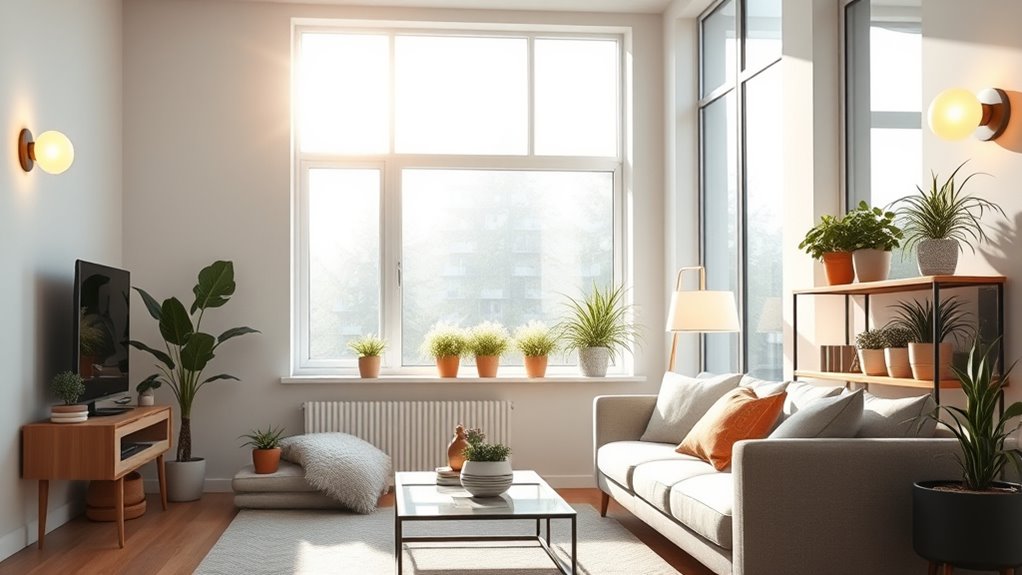
Have you considered how switching to LED lighting can make a difference? LED bulbs use markedly less energy than traditional bulbs, which helps reduce your carbon footprint and lowers your electricity bills. Plus, with features like smart light scheduling, you can optimize when your lights turn on and off, further conserving energy. LEDs also boast a longer LED bulb lifespan, meaning you won’t need to replace them as often, saving money and reducing waste. Additionally, choosing LED lighting with high color accuracy ensures better visual quality and ambiance in your home. Installing LED lighting throughout your home is an easy step toward a more eco-friendly lifestyle. Not only do you cut down on energy consumption, but you also enjoy durable, reliable lighting. Making this switch supports sustainability and keeps your home well-lit efficiently.
Install a Programmable Thermostat for Smarter Heating and Cooling
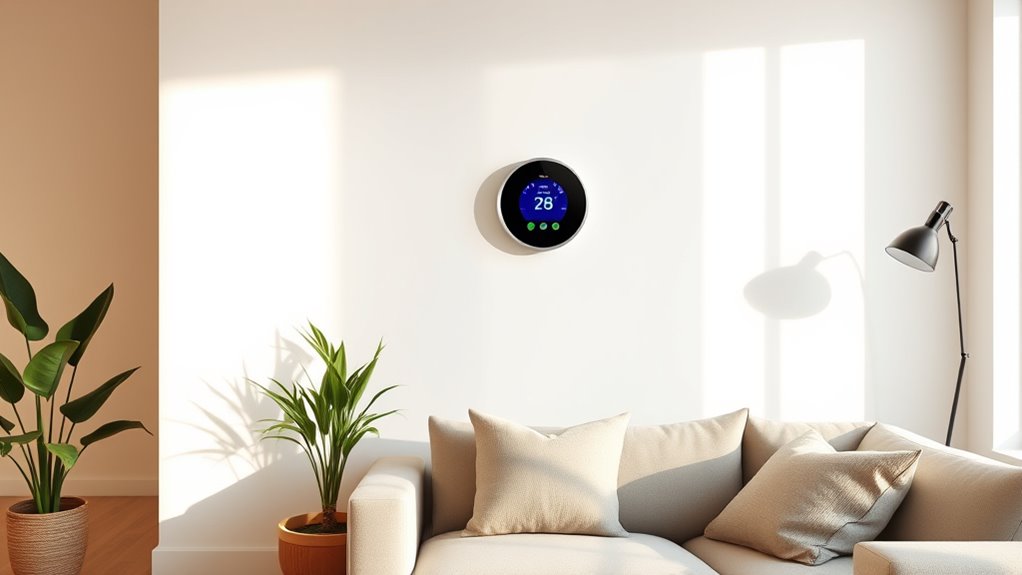
Installing a programmable thermostat allows you to better control your home’s temperature, saving energy and money. By setting it to match your schedule, you can reduce heating and cooling costs while maintaining comfort. This simple upgrade makes your home more efficient and eco-friendly. Additionally, integrating Kia Tuning techniques can optimize your vehicle’s performance, further reducing emissions and contributing to a greener environment.
Smart Temperature Control Benefits
By installing a programmable thermostat, you can optimize your home’s heating and cooling schedules to match your lifestyle, saving energy and reducing utility bills. A smart thermostat offers several benefits:
- Enhanced energy monitoring helps you track usage patterns and identify waste.
- Custom schedules ensure your home stays comfortable without unnecessary heating or cooling.
- Remote control lets you adjust settings anytime, anywhere, preventing energy loss.
- Automatic adjustments improve efficiency by responding to your habits and weather changes.
- Incorporating juice cleansing principles into your routine can further support your eco-friendly lifestyle by promoting healthier habits and reducing reliance on energy-intensive food production.
These features make your system smarter and more efficient, helping you cut costs while lowering your carbon footprint. With a smart thermostat, you gain better control over your energy consumption—saving money and supporting eco-friendly living.
Energy Cost Reduction Tips
To cut your energy costs, consider installing a programmable thermostat that adjusts your home’s temperature automatically based on your schedule. This simple upgrade reduces unnecessary heating and cooling, saving you money each month. For even greater savings, explore solar panel installation to power your home sustainably, lowering reliance on grid electricity. Before making major changes, consult energy audit services to identify inefficiencies and prioritize upgrades. An energy audit pinpoints areas like insulation gaps or outdated HVAC systems, helping you target improvements effectively. Additionally, being aware of vape juice shelf life can prevent waste and unnecessary expenses associated with spoiled products. Combining a programmable thermostat with solar energy solutions and expert audits maximizes your home’s energy efficiency. These steps not only cut costs but also reduce your carbon footprint, making your home greener and more eco-friendly.
Enhanced Home Comfort
Enhancing your home comfort starts with smarter temperature control. Installing a smart thermostat allows you to optimize heating and cooling efficiently. Here are four ways it benefits you:
- Set schedules to match your daily routine, reducing energy waste.
- Adjust temperatures remotely for added convenience and comfort.
- Use sensors to detect when rooms are empty and automatically lower or raise temperatures.
- Combine with natural ventilation to cool your home naturally, decreasing reliance on HVAC systems.
- Staying vigilant about AI vulnerabilities and continuously monitoring your system helps ensure your smart home remains secure and effective. Smart thermostats learn your preferences over time, helping you save money while maintaining a cozy environment. Integrating natural ventilation strategies further enhances comfort without increasing energy consumption. This tech-savvy approach keeps your home comfortable and eco-friendly.
Use Water-Saving Fixtures and Practices
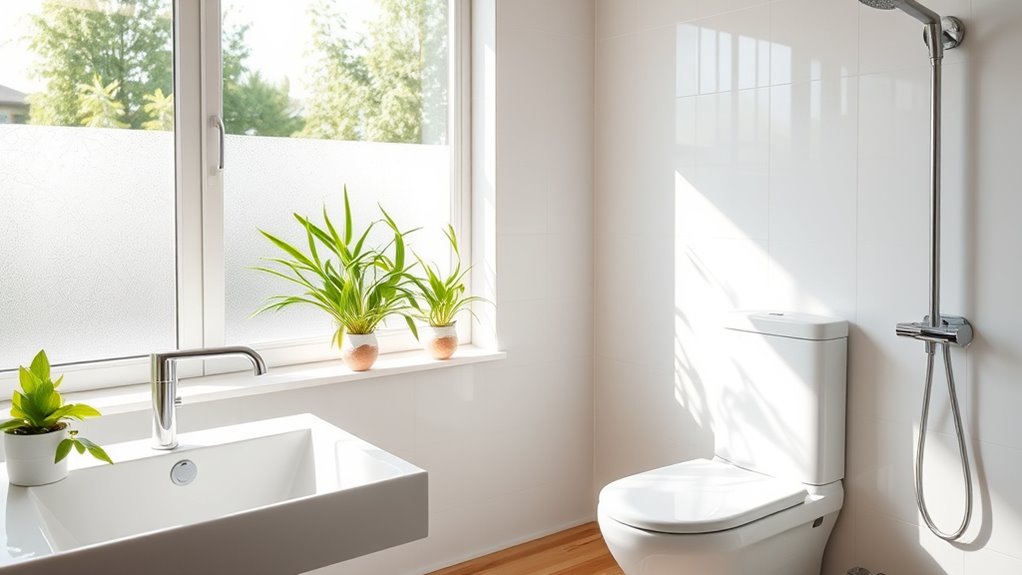
Using water-saving fixtures and adopting mindful practices can considerably reduce your home’s water consumption. Installing low flow showerheads can cut water use by up to 50%, saving both water and energy. Consider replacing standard toilets with dual-flush models to further conserve water. Implementing drip irrigation in your garden ensures efficient watering directly to plant roots, reducing waste and runoff. Always be conscious of water use; turn off faucets when not in use, fix leaks promptly, and collect rainwater for outdoor needs. Using energy-efficient appliances can also help reduce overall water and energy consumption. These small changes add up, lowering your utility bills and decreasing your environmental footprint. By integrating these fixtures and practices into your routine, you contribute to water conservation efforts while enjoying the benefits of an eco-friendly home.
Incorporate Reusable and Eco-Friendly Kitchen Items
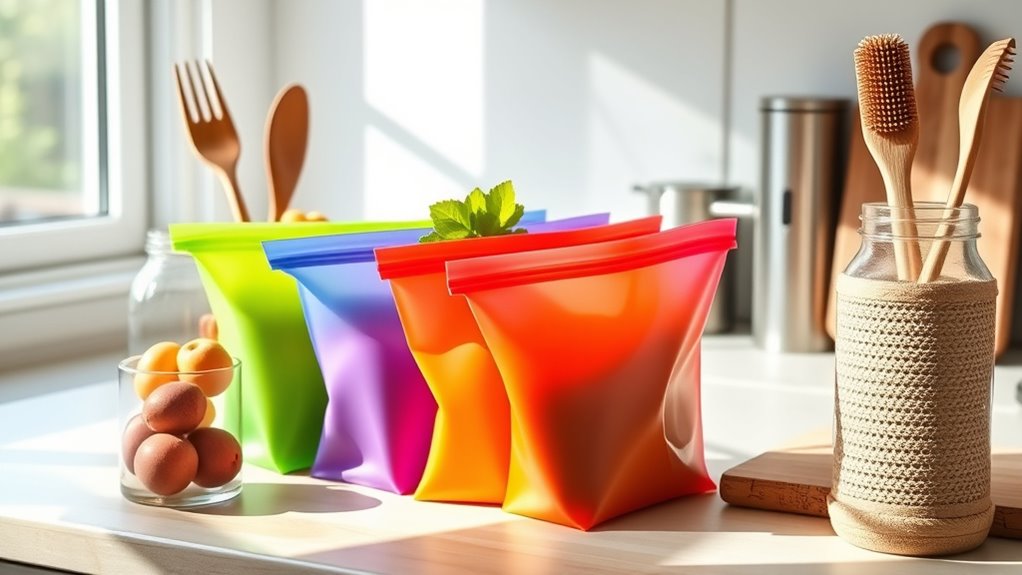
Switching to reusable and eco-friendly kitchen items can substantially cut down on waste and lessen your environmental impact. Here are four simple swaps:
- Use reusable storage containers instead of single-use plastic bags to store leftovers.
- Choose eco-friendly kitchen utensils made from bamboo or stainless steel to replace disposable plastic tools.
- Swap paper towels for reusable cloths, reducing waste and cost.
- Opt for beeswax wraps instead of plastic wrap to cover bowls and keep food fresh.
These small changes make a big difference in reducing landfill waste and plastic pollution. By incorporating reusable storage containers and eco-friendly kitchen utensils into your routine, you’re taking an active step toward a more sustainable home. Plus, these items often save you money over time.
Maximize Natural Light to Reduce Artificial Lighting

You can boost natural light in your home by choosing light-colored walls that reflect sunlight. Installing large windows and keeping them unobstructed allows more daylight to fill your space. These simple steps help cut down on artificial lighting and make your home more eco-friendly. Additionally, incorporating essential oils such as lavender or eucalyptus through diffusers can create a calming atmosphere that enhances your living environment without increasing energy consumption.
Use Light-Colored Walls
Light-colored walls reflect more natural sunlight, making your rooms feel brighter and more spacious. This simple change enhances interior aesthetics and reduces your need for artificial lighting. To achieve the best effect:
- Choose neutral shades like white, cream, or pastels for a clean, airy look.
- Use wall painting techniques such as matte or eggshell finishes to diffuse light softly.
- Opt for high-quality, light-reflective paints that maximize brightness.
- Keep walls uncluttered and free of dark artwork or furniture to further enhance natural light.
- Incorporate eco-friendly paint options to reduce environmental impact and improve indoor air quality.
Install Large Windows
Installing large windows is one of the most effective ways to maximize natural light in your home. Proper window placement is key—you want to position windows where sunlight can flow in throughout the day, reducing your need for artificial lighting. Large windows also boost natural ventilation, helping air circulate and cool your space naturally. This reduces reliance on HVAC systems, saving energy and lowering your carbon footprint. Make sure to consider the orientation of your windows; south-facing windows gather more sunlight in the winter, while shaded or east/west-facing windows can minimize heat gain in summer. By thoughtfully choosing window size and placement, you create a brighter, more energy-efficient home that benefits both the planet and your wallet. Additionally, incorporating automation in building systems can optimize window operation and further enhance energy savings.
Keep Windows Unobstructed
Have you ever noticed how cluttered or blocked windows can diminish the natural light in a room? To maximize sunlight and cut down on artificial lighting, focus on keeping your windows unobstructed. Here are four simple tips:
- Regularly clean your windows to remove dirt and grime, enhancing clarity.
- Opt for minimal window treatments like sheer curtains or blinds that can be easily adjusted.
- Trim any nearby plants or objects that block sunlight from entering.
- Perform routine window maintenance to make sure seals are tight and windows open smoothly.
Compost Food Waste to Minimize Landfill Contributions
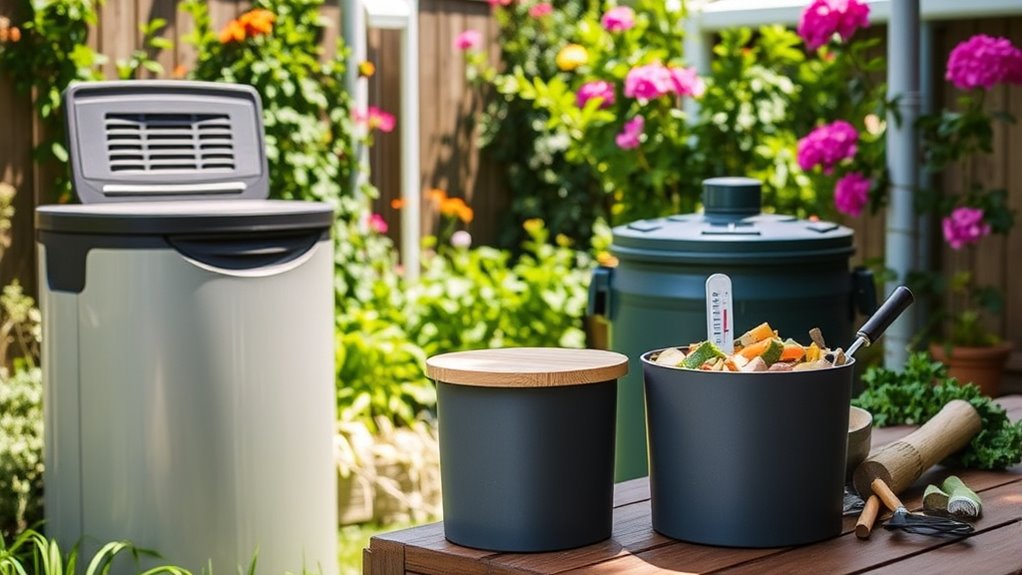
Composting food waste is an effective way to reduce the amount of trash that ends up in landfills and lower your environmental impact. By practicing garden composting, you turn kitchen scraps like vegetable peels and coffee grounds into nutrient-rich soil for your garden. This process not only minimizes landfill contributions but also promotes food waste diversion, keeping organic waste out of trash bins. You can start small with a compost bin or pile in your yard, ensuring proper balance of greens and browns. Composting reduces methane emissions from organic waste decomposing in landfills and helps create healthy soil for your plants. Additionally, understanding the importance of community resilience can enhance your efforts by connecting you with local resources and support networks. Making this simple switch transforms food scraps into a valuable resource while supporting eco-friendly living. It’s an easy step toward a greener, more sustainable home.
Opt for Energy-Efficient Appliances

Since reducing waste is just one part of creating a sustainable home, focusing on energy consumption is also essential. Choosing energy-efficient appliances can considerably lower your electricity bills and decrease your carbon footprint. Look for appliances with high energy star ratings, as they use less energy and last longer, boosting your appliance lifespan. Here are four tips to help you make smart choices:
- Always check the energy star label before purchasing.
- Prioritize appliances with higher energy star ratings for maximum savings.
- Consider the appliance’s lifespan—longer-lasting models reduce replacement waste.
- Use appliances efficiently—run full loads, and avoid standby power when not in use.
Add Insulation and Weatherproofing to Cut Heating and Cooling Costs
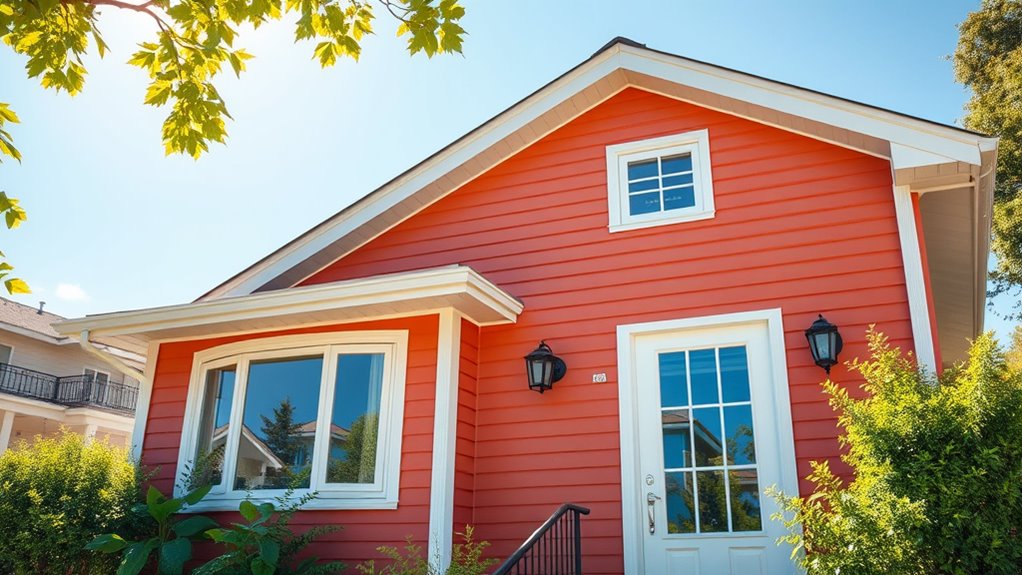
Sealing gaps and cracks around your home makes sure warm or cool air from escaping, lowering your energy bills. Upgrading your insulation materials guarantees your home stays comfortable year-round. These simple steps make a big difference in your eco-friendly efforts.
Seal Gaps and Cracks
To cut down on energy costs, you should focus on sealing gaps and cracks around your home. Start by caulking leaks around windows and pipes to prevent drafts. Next, weatherstrip doors to block cold air from entering and warm air from escaping. Check for hidden gaps near electrical outlets and seal them tightly. Don’t forget to inspect your attic hatch or basement doors—adding weatherstripping here can make a big difference. Finally, seal any cracks in your walls or floorboards with appropriate filler. These simple steps reduce heat loss and lessen the workload on your heating and cooling systems, saving energy and money while helping the environment. Proper sealing is an effective, affordable way to improve your home’s eco-friendliness.
Upgrade Insulation Materials
Upgrading your insulation is one of the most effective ways to reduce heating and cooling costs. Proper insulation installation creates a strong thermal barrier, preventing heat loss in winter and keeping your home cooler in summer. Modern insulation materials, like spray foam or cellulose, are eco-friendly options that improve energy efficiency. When upgrading, focus on areas such as walls, attics, and basements to maximize the thermal barrier’s effectiveness. An improved insulation system reduces the workload on your HVAC, lowering energy consumption and your utility bills. Plus, better insulation contributes to a more comfortable indoor environment year-round. Investing in quality insulation materials ensures your home stays warm in winter and cool in summer, saving energy and protecting the planet.
Grow Your Own Herbs and Vegetables

Growing your own herbs and vegetables is a rewarding way to reduce your carbon footprint and enjoy fresh, organic produce right from your home. Start with herb gardening to add flavor and reduce packaging waste. Then, move on to vegetable planting to supply your kitchen with healthy ingredients. Here are some tips to get started:
- Choose containers or a small garden plot suited for your space.
- Opt for native or easy-to-grow varieties to ensure success.
- Use compost and organic fertilizers to nurture your plants sustainably.
- Water efficiently by collecting rainwater and watering early in the day.
Reduce Single-Use Plastics and Embrace Zero-Waste Habits
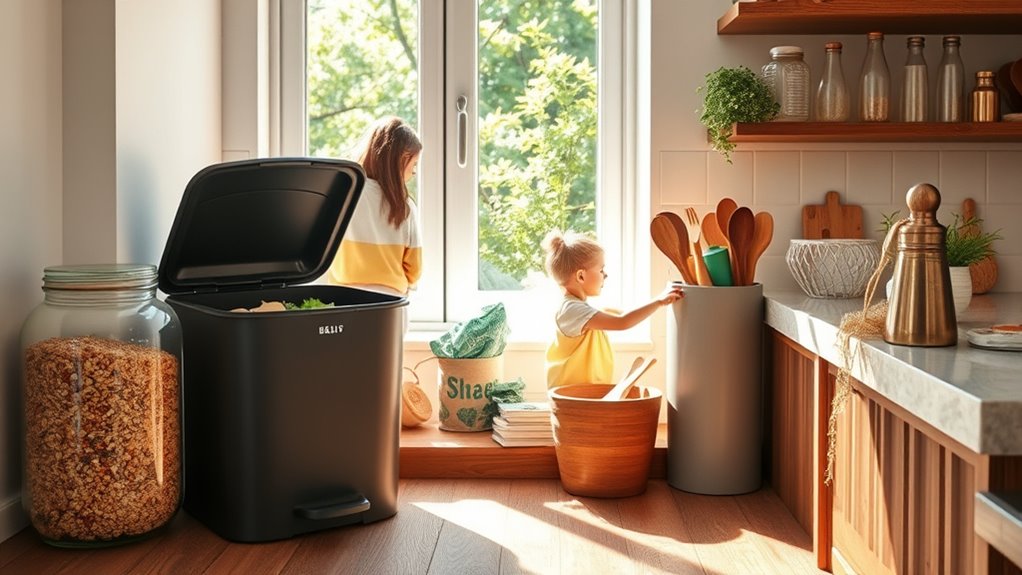
Reducing single-use plastics is a practical step toward minimizing waste and protecting the environment. Start by switching to reusable shopping bags instead of plastic ones—they’re durable, eco-friendly, and save you money over time. When you shop, opt for bulk purchasing to cut down on packaging waste. Buying in larger quantities means fewer plastic containers and wraps, helping you embrace zero-waste habits. Carry reusable produce bags for fruits and vegetables, and avoid single-use plastic bottles by using a refillable water bottle. Be mindful of packaging labels and choose products with minimal or biodegradable packaging whenever possible. Small changes like these add up, making a significant impact on reducing plastic waste and promoting a cleaner, greener planet.
Frequently Asked Questions
How Can I Make My Home More Sustainable on a Tight Budget?
To make your home more sustainable on a tight budget, start small with simple changes. You can install rainwater harvesting systems to reduce water bills and consider DIY solar panel setups if feasible. Use energy-efficient bulbs, unplug devices when not in use, and insulate windows to save energy. These low-cost hacks help the environment and your wallet, making your home greener without breaking the bank.
What Are the Best Eco-Friendly Materials for Home Insulation?
Think of your home’s insulation as its warm hug. You should consider recycled insulation, which repurposes materials and reduces waste, or natural fibers like wool or hemp, which are sustainable and highly effective. These eco-friendly options not only keep your home cozy but also cut down on energy bills. Switching to natural or recycled insulation is like hitting two birds with one stone—better for the planet and your wallet.
How Do I Properly Compost Indoors in Small Spaces?
In small spaces, indoor composting is totally doable. You should start with a compact compost bin, preferably one with a sealed lid to keep odors in check. Place it in a well-ventilated spot, like a kitchen corner, and add your food scraps—vegetable peels, coffee grounds, eggshells—regularly. Remember to turn the compost occasionally, keep it moist, and use browns like shredded paper to balance greens.
Can DIY Energy-Saving Projects Really Reduce My Utility Bills?
Yes, DIY energy-saving projects can really cut your utility bills. Installing solar panels yourself reduces reliance on grid power, saving money over time. Adding smart thermostats helps you control heating and cooling efficiently, lowering energy consumption. Combining these projects boosts your home’s energy efficiency, making a noticeable difference in your bills while helping the environment. With some effort, you’ll see savings and contribute to a greener planet.
What Are Simple Ways to Encourage Family Participation in Eco Habits?
You can encourage family participation in eco habits by creating fun family incentives that motivate everyone. Set up a rewards system for practicing eco-friendly routines, like reducing water use or recycling. Lead by example and involve everyone in planning eco projects. Celebrate your successes together to keep motivation high. When your family sees the benefits, they’ll be more enthusiastic to adopt these habits, making eco-friendly routines a natural part of daily life.
Conclusion
By adopting these eco-friendly hacks, you’re not just tending to your home—you’re nurturing the planet’s delicate soul. Each small change is like planting a seed of sustainability, blossoming into a greener future. With mindful choices, your home transforms into a sanctuary of harmony, where energy flows efficiently and waste diminishes like fading echoes. Together, these habits weave a tapestry of environmental stewardship, proving that even small actions can create a ripple of lasting change.
